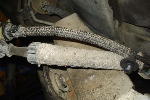I'm going to build log manifolds for my 98 302, after making the dual exhaust from the back to the front, in three steps. It will be all 2.5", for the intended 306 NA engine. When I get to adding a blower, then I'll do a 3" system, and move the 2.5" parts to my 99 truck with the built 306/4R70W swap.
There is plenty of space for log manifolds, but Ford gets stuck in ideas and concepts, even after they are proven to be bad. So they attempted to make a shorty header, ending up with basically a tri-y POS, paired primaries hitting each other at 90* in three points. I want the equivalent of 1 5/8" primaries going to a 2.5" collector, which will be placed near the OEM collector, but using a v-band clamp. That will flow more air than the tiny TM headers, which are the equivalent of a 1.5" equal length header. Those are horrible to install, and the equal length pipes barely gain any power over a simple shorty design. If they had made a shorty header, 1 5/8" pipes, they could have sold five times as many as they have, for maybe $400 a set.










